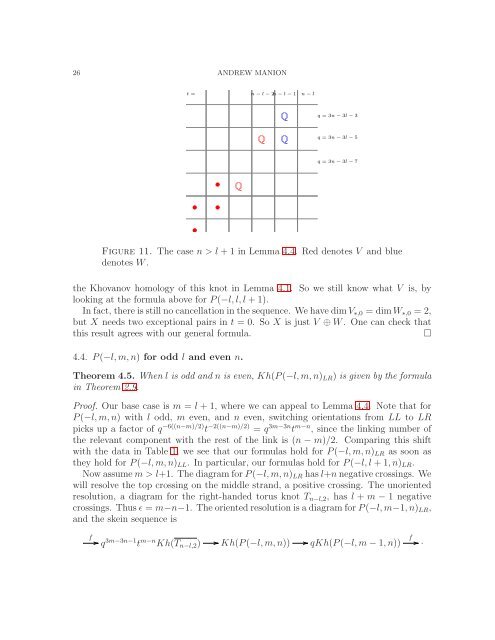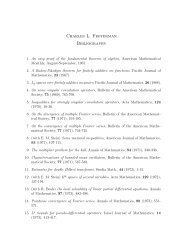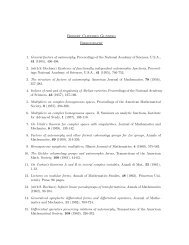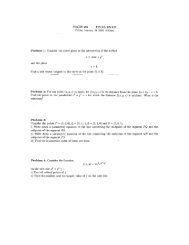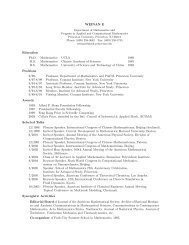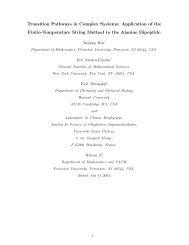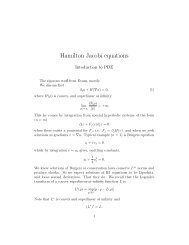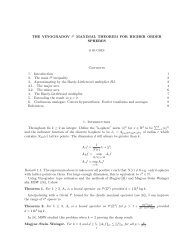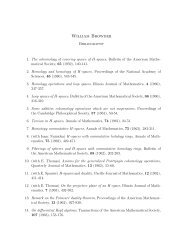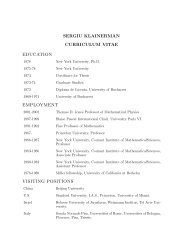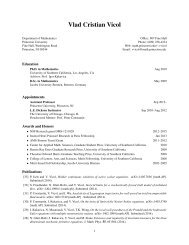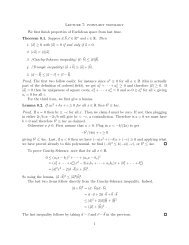The rational Khovanov homology of 3-strand pretzel links
The rational Khovanov homology of 3-strand pretzel links
The rational Khovanov homology of 3-strand pretzel links
You also want an ePaper? Increase the reach of your titles
YUMPU automatically turns print PDFs into web optimized ePapers that Google loves.
26 ANDREW MANION<br />
t =<br />
n − l − 2n − l − 1 n − l<br />
Q<br />
Q<br />
Q<br />
q = 3n − 3l − 3<br />
q = 3n − 3l − 5<br />
q = 3n − 3l − 7<br />
Q<br />
Figure 11. <strong>The</strong> case n > l + 1 in Lemma 4.4. Red denotes V and blue<br />
denotes W.<br />
the <strong>Khovanov</strong> <strong>homology</strong> <strong>of</strong> this knot in Lemma 4.1. So we still know what V is, by<br />
looking at the formula above for P(−l,l,l + 1).<br />
In fact, there is still no cancellation in the sequence. We have dimV ∗,0 = dimW ∗,0 = 2,<br />
but X needs two exceptional pairs in t = 0. So X is just V ⊕ W. One can check that<br />
this result agrees with our general formula.<br />
□<br />
4.4. P(−l,m,n) for odd l and even n.<br />
<strong>The</strong>orem 4.5. When l is odd and n is even, Kh(P(−l,m,n) LR ) is given by the formula<br />
in <strong>The</strong>orem 2.9.<br />
Pro<strong>of</strong>. Our base case is m = l + 1, where we can appeal to Lemma 4.4. Note that for<br />
P(−l,m,n) with l odd, m even, and n even, switching orientations from LL to LR<br />
picks up a factor <strong>of</strong> q −6((n−m)/2) t −2((n−m)/2) = q 3m−3n t m−n , since the linking number <strong>of</strong><br />
the relevant component with the rest <strong>of</strong> the link is (n − m)/2. Comparing this shift<br />
with the data in Table 1, we see that our formulas hold for P(−l,m,n) LR as soon as<br />
they hold for P(−l,m,n) LL . In particular, our formulas hold for P(−l,l + 1,n) LR .<br />
Now assume m > l+1. <strong>The</strong> diagram for P(−l,m,n) LR has l+n negative crossings. We<br />
will resolve the top crossing on the middle <strong>strand</strong>, a positive crossing. <strong>The</strong> unoriented<br />
resolution, a diagram for the right-handed torus knot T n−l,2 , has l + m − 1 negative<br />
crossings. Thus ǫ = m−n−1. <strong>The</strong> oriented resolution is a diagram for P(−l,m−1,n) LR ,<br />
and the skein sequence is<br />
f<br />
q 3m−3n−1 t m−n Kh(T n−l,2 ) Kh(P(−l,m,n)) qKh(P(−l,m − 1,n))<br />
f<br />
.


